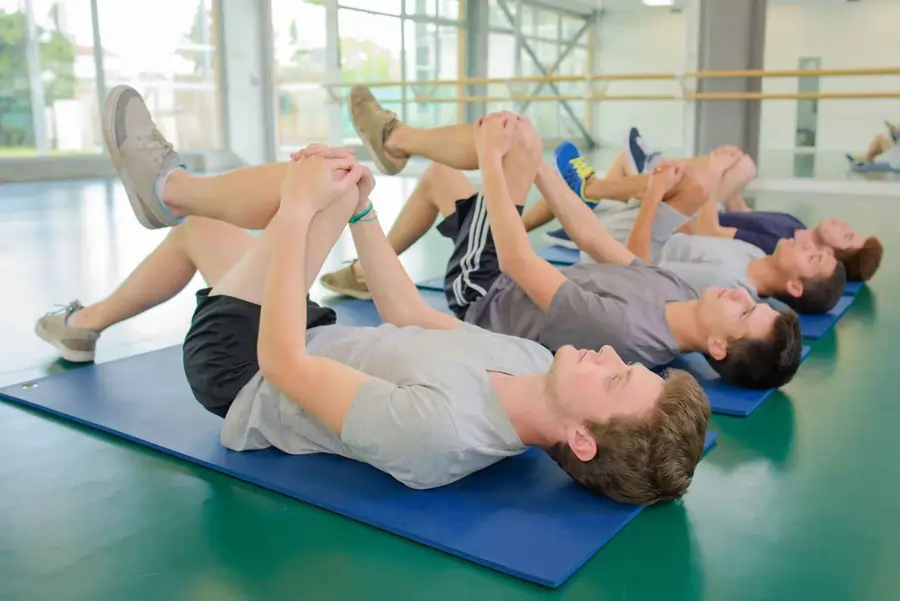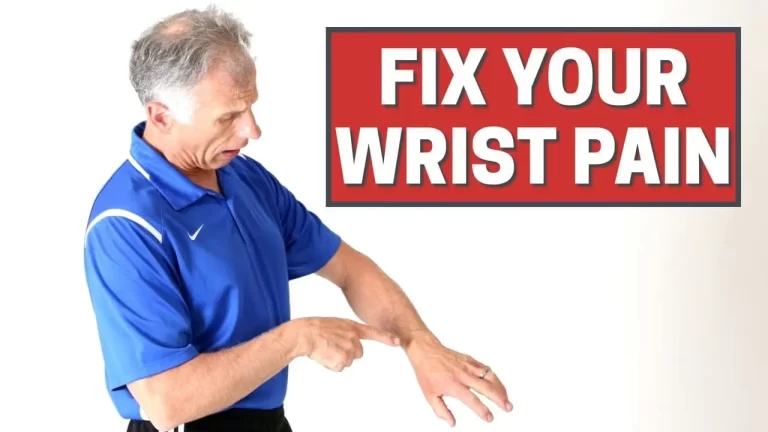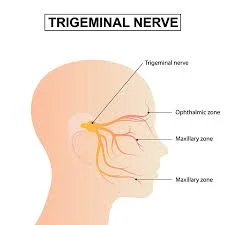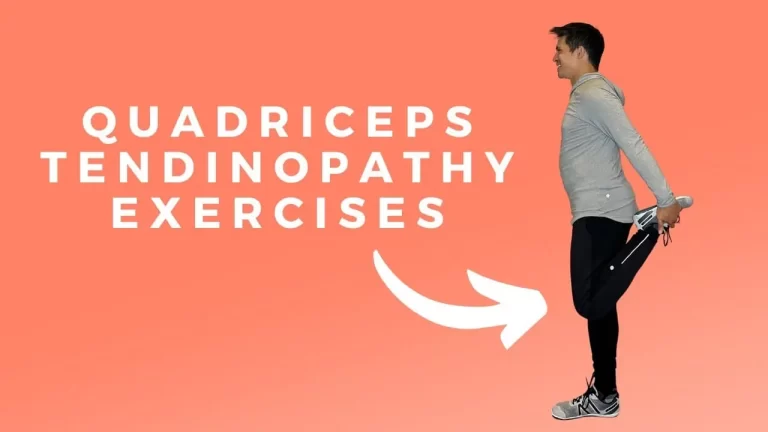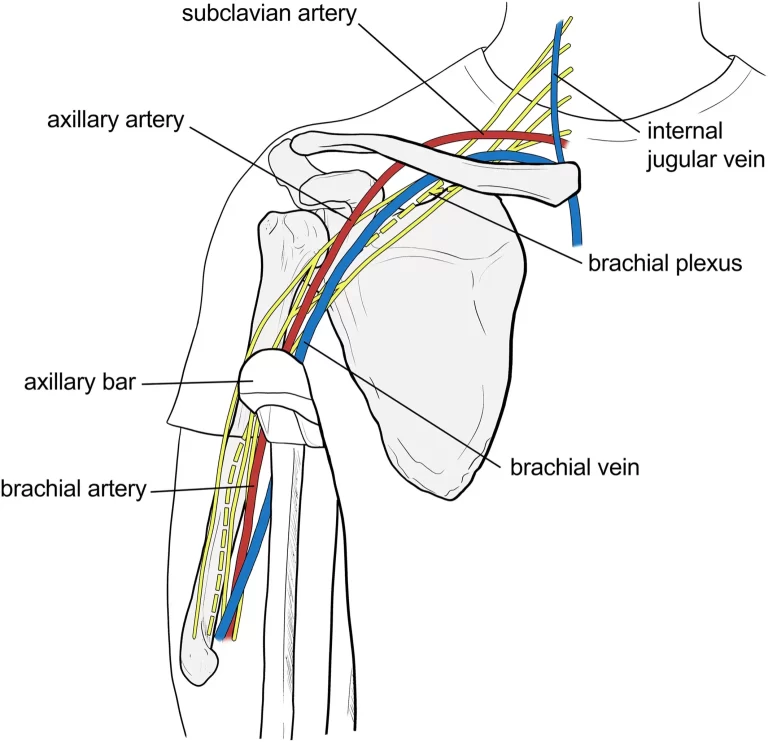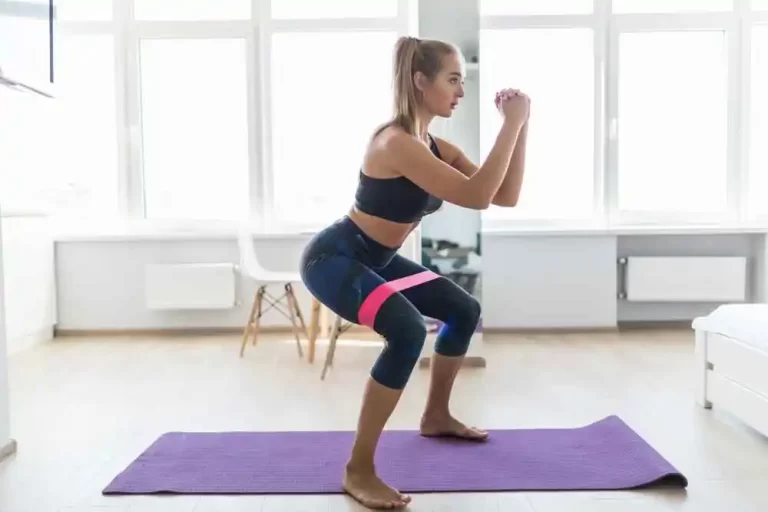30 Best Exercises For Sciatica Pain
Exercises for sciatica pain offer a proactive and natural approach to alleviate discomfort and improve mobility for those suffering from this often debilitating condition.
Sciatica pain can be quite painful and frequently radiates down the legs and buttocks from the lower back. It happens when irritation or compression of the sciatic nerve passes from the lower back via the hips and down each leg. A ruptured disc, spinal stenosis, or even something as basic as bad posture can all contribute to this problem.
Certain stretches and exercises can help relieve pain, reduce tightness, and promote healing for people who suffer from sciatica. However, a variety of exercises and stretches may reduce pain and speed up healing.
Introduction:
Starting in your lower back, the sciatic nerve passes through your hips, buttocks, and down each leg. Sciatic pain usually follows the route of the sciatic nerve in the affected leg. It happens whenever a nerve along this pathway is compressed or irritated. When treating sciatica, conservative measures like rest, ice, heat, and over-the-counter painkillers usually work well.
Physical therapy is a potential therapy for managing sciatica pain without surgery. The goal of physical therapy is to provide relief by relieving pressure or pinching on the nerve through a range of techniques and exercises that reduce pain and muscle spasms while increasing core strength and back range of motion.
The most popular method of treating sciatica pain is a forward-looking, exercise program. The goal of physical therapy is to determine the root cause of the pain, treat it, and stop it from happening again.
If you have any additional medical problems, consult your physician before doing these sciatica exercises. If your pain gets worse after working out, see your doctor.
Why would someone have sciatica pain?
In the body, the sciatic nerve is the most long and thickest nerve. It begins with five lower back nerves that combine to produce a single nerve that passes down the leg and through the buttocks. The inflammation of the sciatic nerve is commonly referred to as “sciatica”. It may result in a pain that radiates down the leg or that burns or shoots through the buttocks. Usually, there is only one side that hurts.
There could be a bone spur on the spine or a herniated disk pressing on the nerve, causing pain. Sciatica is the prevalent term for leg pain, tingling, weakness, or numbness. This results in damage or pinching of the sciatic nerve.
What symptoms and signs are present with sciatica?
Sciatica is a condition marked by pain that moves down your leg and your buttocks from your lower back or lumbar spine. Almost anywhere along the nerve pathway may cause you to experience pain, but it is most likely moving from your lower back to your buttock, the back of your thigh, and your calf.
There is a wide range of pain that may consist of from a slight ache to a sharp burning feeling or unbearable pain. Sneezing or coughing can make it more severe, and sitting for extended periods can make symptoms worse. Typically, the effects are limited to one side of the body.
Some patients additionally experience numbness, tingling, or weakness in the impacted leg or foot. One part of your leg may be numb, while another may hurt.
For patients with sciatica, some of the goals of physical therapy include as follows:
The purposes of physical therapy and exercise in the treatment of sciatica symptoms and indicators are as follows:
- Increase your lower body’s range of motion.
- Decrease thighs, buttocks, lower back, and leg pain
- Regain pain-free, useful movement patterns
- Improve the rehabilitation phase of the lower back
- Reduce spasms in the muscles
- Reduce the anxiety of moving and stop future episodes of pain
How does exercise relieve sciatica pain?
Sciatica pain is one type of injury that may heal with exercise as opposed to rest. Staying active once the pain passes may also help keep it from coming back.
A reduction in sciatica symptoms could be impacted by the following factors:
- Increased blood flow
Blood flow to the nearby muscles and nerves is improved by exercise. Increased blood flow increases the movement of toxins and inflammation out of the area while providing fresh blood and nutrients to the area.
- Relieve pain and inflammation
Physical therapists can help reduce muscle tension and inflammation surrounding the sciatic nerve by using manual therapy techniques like massage, stretching, and targeted exercises. This is going to reduce the amount of pain.
- Improved health of soft tissues
Frequent sciatica mobilization exercises may help maintain and repair the disks’ soft tissues. low-impact exercise may improve tissue quality and other intervertebral disc material qualities.
- Better health of nerves
The purpose behind the exercise is to help the spinal and nerve tissues “loosen up” and become more flexible.
- Improved strength in the muscles
Exercise improves muscle strength by increasing the area and activation (or proper engagement) of the deep muscle fibers. Stronger muscles contribute to the stability of the spine by supporting it. Muscle tiredness pain is also reduced.
- Become more flexible and extend your range of motion.
Tight hamstring and buttock muscles may worsen sciatica. Physical therapy exercises that target these areas of increased flexibility can improve the range of motion in your legs and lower back while also relieving pressure on the sciatic nerve.
- Improve your coordination and balance
It takes balance and coordination to prevent falls and other injuries that could make sciatica worse. Physical therapy exercises will help you become more balanced and coordinated, which will allow you to move safely and effectively.
- Instruct on proper body mechanics and posture
Physical therapists can teach you these skills to help reduce the strain on your spine and sciatic nerve when performing daily activities. This could help prevent sciatic pain from happening again.
How is a case of sciatica pain diagnosed?
Based on your symptoms, specifically pain that travels down your leg, sciatica is diagnosed. Back pain is usually not as bad as leg pain. Along with certain testing, your doctor will perform a neurologic examination. The straight leg lift test is one of the examinations, which is designed to identify sciatic nerve pain. Your straight leg is raised by your doctor throughout the test to see if it hurts. The test is positive if your pain level has increased.
When a person has neurologic symptoms that are severe or getting worse, or when other serious illnesses might be present, imaging studies (MRI) are advised.
X-rays: These images can show spinal canal narrowing or bone spurs, but they are usually not able to show soft tissues like herniated discs.
Magnetic resonance imaging (MRI) scans: An MRI can give you an in-depth examination of your spine and the surrounding tissues, including the sciatic nerve. This could help identify where your sciatica is coming from.
It’s important to keep in mind that diagnosing sciatica should ideally be done based on the unique symptoms rather than just imaging tests. Imaging tests can identify abnormalities that aren’t the cause of the patient’s pain.
How to relieve sciatica pain with stretches and exercises:
Sciatica, on the other hand, typically results from pressure on the nerves that go to the lower back. Like with simple lower back exercises, if you’re having back pain, you can extend your lower back to relieve some of the stress and strain that leads to sciatic pain.
Additionally, stretches that target your hamstrings and calves may help relieve sciatica pain. Stretches that target the hamstrings and calves will also target the sciatic nerve because they move in the same direction as these muscle groups. Additionally, sciatic nerve pressure can be reduced by stretching the piriformis. since depending on your unique anatomy, the sciatic nerve may pass through, over, or under the piriformis muscle.
By reducing stress in the location that may be causing the sciatic nerve pain, some strength exercises may help with sciatica. This is because they transfer load more evenly around the body. To put it simply, strength exercises help your musculoskeletal system operate more smoothly by coordinating its various components.
How much exercise is advised each day?
A couple of times a day, perform the exercises while keeping in mind the advice following.
- Workouts are frequently organized based on the level of difficulty.
- Once you feel that you have attained this suitable intensity, keep on with the activity.
- The exercise may be too difficult for you if you feel like you are exerting more effort than this; in that case, return to the simpler one.
- The standing exercises should be done with support provided if needed.
The following safety precautions should be considered before starting an exercise program:
Before starting any workout program, it’s important to think about a few safety precautions and increase the advantages. Consult your physician or physical therapist for advice about which exercises are best for your specific issue.
It’s important to pay attention to what your body needs and avoid exerting power when it hurts. A frequent side effect of exercise is some pain, but chronic or severe pain might suggest overwork. Work your way up to more difficult workouts by beginning with low-impact ones until you can handle additional pain.
Maintaining proper form and posture is important for avoiding repeated injuries. If you’re not sure how to start exercising properly, consult a doctor. Warm up before starting any exercise to make your joints and muscles ready for the task.
Best Exercises for Sciatica Pain:
Exercise works better to cure sciatica pain than bed rest or continuing a regular physical exercise routine.
Seated glute stretch
- You sit cross-legged or blend-legged in the seated glute stretch.
- Seat yourself in the chair and extend your legs straight out in front of you.
- Put your right ankle over your left knee by flexing your right leg.
- Bend forward, letting your upper body reach toward your thigh.
- Hold this position for a few seconds.
- Then return to your neutral position.
- Then relax.
- Repeat this exercise three to five times.
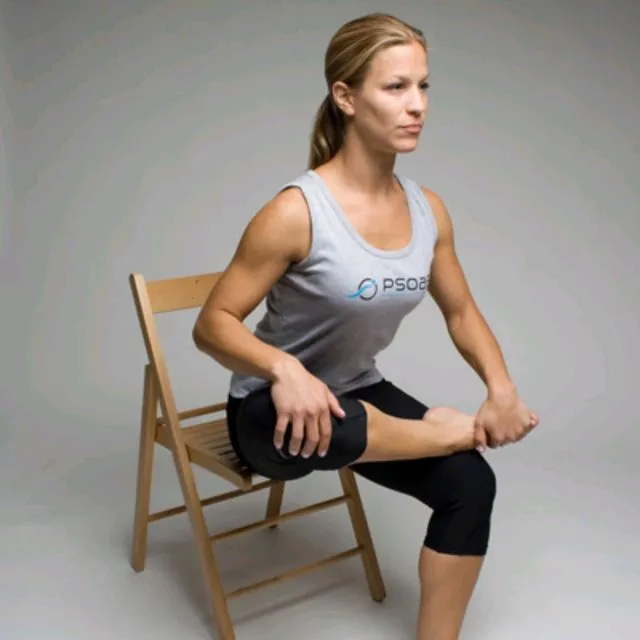
Seated spinal twist
- Both of your legs should be extended in front of you as you take a comfortable seat on the floor.
- Next, place your left knee flat on the outside of your right leg while bending it.
- Right now, place your right arm outside of your left leg.
- Continue to maintain your hand behind you.
- Turn your body to the left lightly.
- Hold it for a few seconds.
- Then return to your neutral position.
- Then relax.
- Repeat this exercise three to five times.
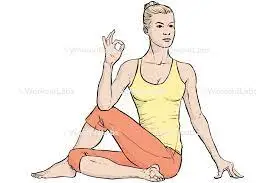
Pelvic tilt
- Relax and lie down on the bed or table to start.
- Bend your knees gently.
- Either place your hands on your chest or keep them by your sides.
- The muscles in your abdomen should be tense.
- Hold this position for a few seconds.
- Then return to your neutral position.
- Then relax.
- Repeat this exercise three to five times.
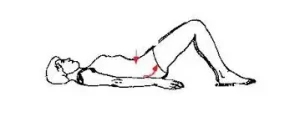
Pigeon Pose
- Start by finding a comfortable spot and place your hands on the floor behind your knees.
- Squeeze your abdominal muscles at this point.
- Next, extend your left knee to the left while moving it forward.
- Push your right leg back and pull your toes close together.
- Stretch your left toes.
- Keep your back straight as you lift your head.
- Hold this position for a few seconds.
- Then return to your neutral position.
- Then relax.
- Repeat this exercise three to five times.
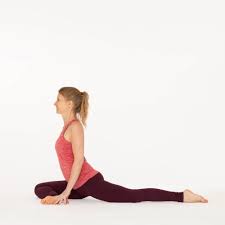
Child’s Pose
- Start by bending down to a comfortable position.
- Maintaining the proper position of your knees and hips.
- Take a breath, then bend forward to lower your body.
- Press your forehead firmly into the ground’s surface.
- Holding your arms straight out in front is suitable.
- Hold this position for a few seconds.
- Release the breath.
- Then return to your neutral position.
- Then relax.
- Repeat this exercise three to five times.

Bridges
- To start, take a comfortable position on the bed.
- With your feet flat on the bed, bend your knees at this moment.
- Next, contract your abdominal muscles.
- Lift your upper body.
- Kindly keep your arms at your sides.
- Hold this position for a few seconds.
- Lower your body.
- Then return to your neutral position.
- Then relax.
- Repeat this exercise three to five times.
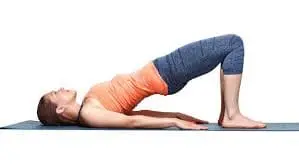
Piriformis stretch
- To begin, lay down on your back on the ground.
- Be careful to flex each knee.
- Keep your feet straight on the ground.
- Put your right ankle up against your left thigh at this point.
- Put your hands on your leg’s left side.
- Extend your leg toward the center of your body.
- Hold this position for a few seconds.
- Then return to your neutral position.
- Then relax.
- Repeat this exercise three to five times.

Back extensor exercise(cobra pose)
- Lie flat on the ground with your palms facing your shoulders.
- Holding your sides, your elbows should be straight back.
- Take a step back and maintain a neutral neck posture as you look directly down at your mat.
- Ensure that your back is securely set on the surface of the ground.
- Inhale deeply to lift your chest off the floor.
- Keep your lower ribs in place and roll your shoulders back.
- Make sure to maintain your elbows by your sides.
- Stop them from heading in separate directions.
- Keep your neck in a neutral position.
- Hold this position for a few seconds.
- Exhale to get back on the ground.
- Then return to your neutral position.
- Then relax.
- Repeat this exercise three to five times.
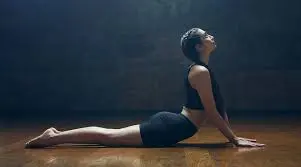
Straight Leg Raise
- Lie down in a comfortable position on the floor or a table to get started.
- Now flex your knee slightly.
- Then slowly raise your leg.
- While the opposing side’s knee stays straight.
- Hold this posture for a short while after that.
- Lower your leg after that.
- Then return to your neutral position.
- Then relax.
- Repeat this exercise three to five times.
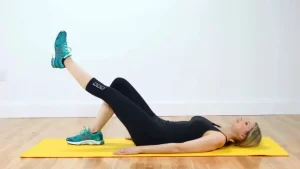
Prone leg raise
- While lying face down, you might want to move your head to one side if that makes you feel more comfortable.
- Contract your stomach and buttocks while you raise one leg slightly off the ground, maintaining your hip range level.
- Hold this position for a few seconds.
- Lower your leg.
- Return to your neutral position after that.
- Then relax.
- Repeat this exercise three to five times.
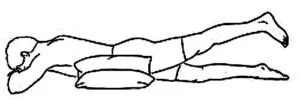
Partial curls
- Lay down on the ground to start.
- Now flex your knees.
- Maintain a flat foot hit on the ground.
- Put your hands over your head.
- Inhale deeply.
- Next, progressively lift your shoulders a few inches off the ground.
- Hold this posture for a few seconds.
- After that, lowers gradually.
- Then return to your neutral position.
- Then relax.
- Repeat this exercise three to five times.
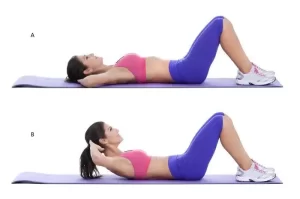
Seated-piriformis-stretching
- To start this stretch, take a seat in a chair and cross your painful leg over the other leg’s knee.
- Try to maintain a straight back while bending forward with your chest.
- If it doesn’t hurt, try leaning over a little bit more.
- If you experience pain, stop.
- Hold this posture for a few seconds.
- Then return to your neutral position.
- Then relax.
- Repeat this exercise three to five times.
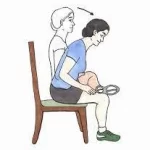
Knee to the opposite shoulder
- With your legs stretched and your feet bent upward, lie flat on your back.
- Bend your right leg and hold the knee with your hands.
- Pull your right leg carefully over your body and toward your left shoulder.
- Keep it there for a short while.
- Never forget to just pull your knee as far as you find comfortable.
- Your muscles should release tension by stretching, not by aching.
- Push your knee to return your leg to its original position.
- Then return to your neutral position.
- Then relax.
- Repeat this exercise three to five times.
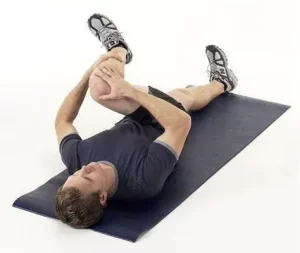
Standing hamstring stretch
- Position your right foot on a surface that is elevated at or below hip level.
- This might be a stairway step, a stool, or a chair.
- To maintain a straight leg and toes, flex your foot.
- Maintain a small bend in your knee if it tends to hyperextended.
- Your body should be a bit bent forward toward your foot.
- The stretch gets deeper as far as you proceed.
- Do not push yourself over where it hurts.
- Instead of raising your leg higher, let your hip slide down.
- Hold this posture for a few seconds.
- Then return to your neutral position.
- Then relax.
- Repeat this exercise three to five times.
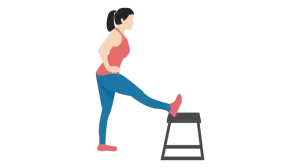
Standing piriformis stretch
- While standing, place your painful leg over your other leg’s knee.
- Try to form the number 4 by bending your standing leg and lowering your hips to the floor at a 45-degree angle.
- You can move your arms and bend your waist by keeping your back straight.
- Hold this posture for a few seconds.
- Then return to your neutral position.
- Then relax.
- Repeat this exercise three to five times.
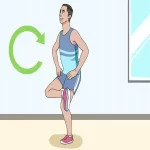
Scissor hamstring stretch
- The distance between your right and left feet should be three feet.
- Although your right hip shouldn’t extend further forward than your left, you should press your shoulders back and pull your hips forward.
- Your hands should be on your hips.
- Use a chair to support with balance if needed.
- Bend your waist slightly while maintaining a straight back to push your body over your front leg.
- Keep the weight of your front leg stable.
- Hold this posture for a few seconds.
- Then return to your neutral position.
- Then relax.
- Repeat this exercise three to five times.
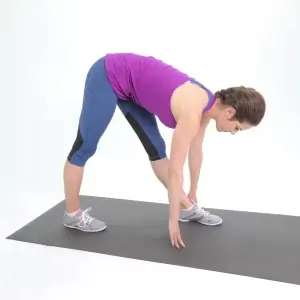
Clamshell
- Take a side-laying position and flex both legs.
- To support your head, put your lower arm under it.
- Pull your belly button inside toward your spine by using your core.
- Raise your top knee gradually while keeping your feet together to spread your legs apart.
- Use your upper arm for stability to prevent rolling towards your back.
- Hold this posture for a few seconds.
- Then return to your neutral position.
- Then relax.
- Repeat this exercise three to five times.
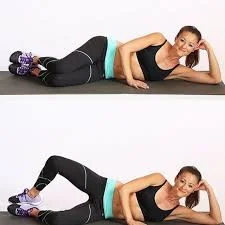
Bird-Dog
- Pick a location that allows you to extend both your arms and legs at the same time.
- Place your hands firmly on the ground, shoulder-width apart, and kneel on an exercise mat or other altered surface.
- Pull your belly button inside toward your spine by using your core.
- To prevent straining your neck, look forward and slightly downward, about a foot in front of your hands.
- Extend your right leg straight behind you and raise your left arm straight up in front of you. (You can complete both at once or one at a time.)
- Verify that they are facing the same direction as you.
- Hold this posture for a few seconds.
- Lower your leg.
- Ensure that your back remains straight and is not lowered or slumped.
- Change your point of view if you have a pain in your neck.
- Then return to your neutral position.
- Then relax.
- Repeat this exercise three to five times.
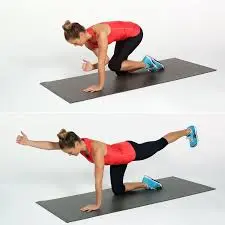
Lower Trunk Rotations
- On an exercise mat, begin in the supine position (lying on your back).
- Maintain the bent knee position and flat feet on the ground.
- Make sure your shoulders and upper body are well grounded.
- As you complete the exercise, raise your arms and place them on the ground to improve your balance.
- Tighten or contract your abdominal muscles.
- Within your range of motion, mindfully and slowly rotate your knees to one side.
- Even though they will move, your feet are going to stay on the ground.
- Hold this posture for a few seconds.
- Then return to your neutral position.
- Then relax.
- Repeat this exercise three to five times.
- During the workout, maintain your focus and breathing pattern.
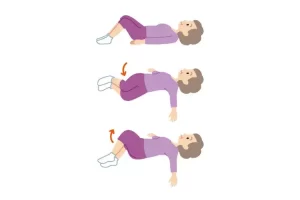
Downward-Facing Dog
- Lie down on all fours with your hips over your knees and your shoulders over your wrists.
- Put pressure on your hips to raise them toward the ceiling using your hands.
- As you divide your weight properly between your hands and feet, keep your knees slightly bending.
- To bend your shoulders overhead and keep your spine straight up, move your head toward your feet.
- Hold this posture for a few seconds.
- Then return to your neutral position.
- Then relax.
- Repeat this exercise three to five times.
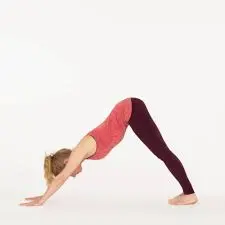
Half Moon Pose (Ardha Chandrasana)
- Start from a standing position, like Triangle, with your right foot in front.
- Give your weight to your right foot and flex your right knee a little more.
- Utilizing your left hand, lift your hip.
- Slide your left foot forward a few inches in front of and to the right of your right foot as you extend your right hand.
- Press out through your left heel and raise your left leg so that it is parallel to the floor.
- Look forward while rotating your body and opening your hips.
- To go even further, lift your left hand toward the ceiling while looking upward.
- Hold this posture for a few seconds.
- Lower your left leg to the floor, bend your right leg, and slowly release it to return to the starting position.
- Then relax.
- Repeat this exercise three to five times.
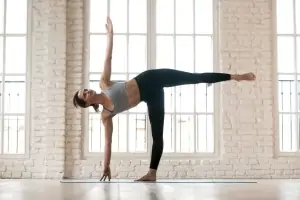
Locust Pose (Salabhasana)
- Place your fingers together at the base of your spine and lie on your stomach.
- Raise your head, arms, and chest as far as you can while still maintaining gentle movement.
- Raise and extend your arms from your body.
- Raise one leg at a time or both legs to go deeper.
- Activate your abs, lower back, and glutes.
- Hold this position for a few seconds.
- Release the pose and go back to where you were before.
- Take a few deep breaths, rest, and relax your body while slowly shifting your hips from side to side.
- Then relax.
- Repeat this exercise three to five times.
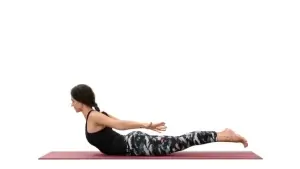
Double knees to chest
- Begin by lying on your back on a comfortable surface, like a bed, or yoga mat.
- Gently pull both hands, as if you were holding them, inwards into your chest from behind your knees.
- Hold this posture for a few seconds.
- Maintain a comfortable posture with your head and shoulders while holding this stretch.
- If you have trouble holding behind your knees, you can help yourself with this exercise by using a towel, belt, or strap behind your knees.
- Then return to your neutral position.
- Then relax.
- Repeat this exercise three to five times.
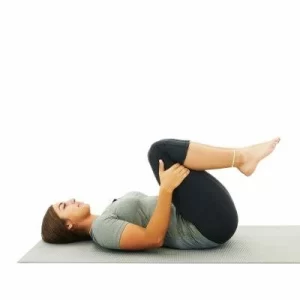
Sciatic Nerve Flossing
- Placing your knees shoulder-width apart and your feet flat on the ground, take an upright seat in a chair.
- Straighten one leg, bring the foot in close to the body, and lean your head back.
- Then, point your foot forward and lower your eyes until your chin is close to your chest.
- Hold this position for a few seconds.
- Then return to your neutral position.
- Then relax.
- Repeat this exercise three to five times.
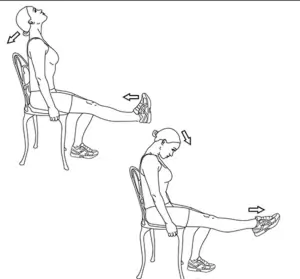
Hamstring Stretch
- While lying on your back, wrap a resistance band around the back of one thigh, holding both ends of the band to support the thigh.
- Maintain a flat surface with the other leg.
- While trying to reach the bottom of the foot parallel to the ceiling, slowly straighten the knee until a stretch is felt in the back of the thigh.
- Maintain a straight leg at all times, only bending the knee when it seems comfortable.
- Hold this position for a few seconds.
- Then return to your neutral position.
- Then relax.
- Repeat this exercise three to five times.
Back extensions
- On the floor or an exercise mat, lie on your stomach.
- With your forearms supporting your upper body by resting on your elbows, lie flat on the ground.
- Press strongly with your elbows to extend and stretch your spine.
- Your back will rise as a result, and your abdominal muscles will stretch.
- Hold this position for a few seconds.
- Then return to your neutral position.
- Then relax.
- Repeat this exercise three to five times.
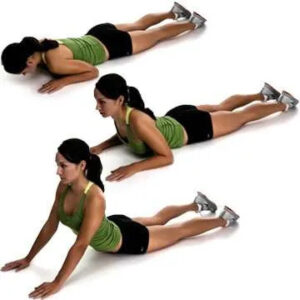
Legs up the wall pose
- Sit on the floor with one hip pressed up against a wall.
- Raise your legs and feet so they rest against the wall as you lean forward onto your back.
- Foot distance should be roughly hip-width apart.
- All you have to do is drag the backbone as near to the wall as possible without making contact with it.
- Your lower body should be fully supported by the wall.
- With your hands facing up, gently extend your arms to either side of your body.
- Let go of your upper body muscles.
- Imagine yourself relaxing on the ground.
- Take a few moments to rest in this pose, or as long as it seems comfortable.
- Bend your knees and move to one side to release.
- Take a few deep breaths, then push back into your hands to sit again.
- Then relax.
- Repeat this exercise three to five times.
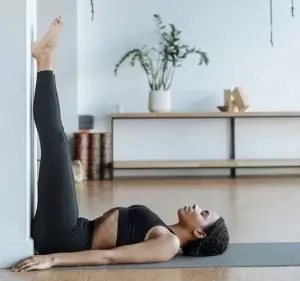
Cow Face Pose (Gomukhasana)
- Place your legs straight out in front of you when you sit down.
- Bend your right knee, cross your right leg over your left leg, and try to bring your knees up while keeping your right foot as close to or outside of your left leg as you can.
- Bring your left foot to the outside of your right hip while bending your left knee.
- If they are not exactly in line, that’s okay.
- Extend your spine and lift out of your lower back.
- Hold this position for a few seconds.
- Then return to your neutral position.
- Then relax.
- Repeat this exercise three to five times.
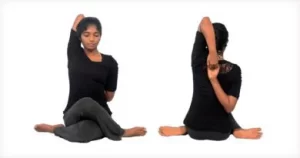
Forearm Plank
- Put your forearms in front of you, palms facing the floor, and lay facedown on the floor with your elbows exactly below your shoulders.
- As you elevate yourself onto your elbows and toes, evenly distributing your body weight across the toes and elbows, contract your abs.
- Spread your fingers and keep your palms facing the floor to provide stability.
- From your heels to your shoulders, create a straight line.
- Hold this position for a few seconds.
- Then return to your neutral position.
- Then relax.
- Repeat this exercise three to five times.
Cat-Cow Stretch
- Start by setting your hands on the ground in the tabletop posture.
- Make sure you have a straight back.
- To stay grounded, use both hands and feet.
- Take a deep breath, hold your head up, and allow air to fill your stomach.
- Hold this position for a short amount of time.
- Next, push your chin into your chest, release the breath, and bend your back toward the ceiling.
- Your lower back is extended gently.
- Hold this position for a few seconds.
- Then return to your neutral position.
- Then relax.
- Repeat this exercise three to five times.
Here are some suggestions to remember when working out:
- Stretching before and after each exercise, along with performing the right amount of repetitions for each, are important parts of the protocol that must be followed when performing any exercise.
- When working out, it’s important to maintain proper posture.
- Exercise should be stopped immediately if you experience any form of pain.
- Wear loose-fitting clothes that won’t restrict your movement while working out.
- Refrain from wearing excessively tight clothing.
- Before beginning any exercise, stretch and warm up.
- It is safe to stretch a tight muscle, and even if it hurts, it shouldn’t hurt too much or too quickly.
- Between each workout, take a break.
- Avoid participating in a lot of intense physical activity.
- To prevent injury, make sure there is enough space around you, and don’t forget to stay hydrated during workouts.
When should you stop working out?
- You’re ill and experiencing symptoms.
- If exercise causes pain, stop.
- Blurry vision
- High temperature
- Headache
What is the most effective way to avoid sciatica pain?
A few simple prevention measures could help lower the chance of sciatica or stop the damage to the spine that could be the source of the pain.
Some basic suggestions for prevention are as follows:
- Take part in regular exercise.
- Your core muscles, which are the muscles in your abdomen and lower back that are important to good posture and alignment, should receive extra attention if you want to maintain a strong back.
- Being overweight can worsen sciatica by increasing the strain on the lower back and increasing the risk of disc problems. so maintain a healthy weight.
- Consult your physician for advice on particular activities.
- Stretching regularly improves flexibility and reduces the chance of sciatic nerve compression in the lower back, calves, and hamstrings.
- keeping a supported posture whether sitting, standing, or walking.
- Minimizing how much time is spent sitting or standing.
- Avoid painful exercises before warming up, such as bending and twisting.
- Allowing the muscles to warm up before using them.
- Smoking decreases blood flow to the spine, which can worsen inflammation and slow the healing process, both of which can contribute to sciatica. so quit smoking.
- Pillows under the knees when sleeping on the back, or between the legs when resting on the side
- Applying heat or cold packs helps relieve pain and minimize inflammation
- Regular low-impact activity, such as walking
Exercises to Avoid for Sciatica:
People with sciatica pain may find different workouts to be painful, so they must find what works best for them. The following exercises could be risky at first since they increase the strain on the hips and lower back. But with time and physical therapy, people could discover they can perform these movements pain-free once more.
- Lifting both legs off the ground
This is lying on your back with your legs straight, lifting both of them toward the ceiling with your core muscles, and then slowly lowering them back to the floor.
- Supine leg circles
An individual begins this exercise by laying on the floor with their arms and legs out straight. With their foot, they create small circles while lifting one leg toward the ceiling.
- Hurdler stretch
Place one bent leg on the floor and place the sole of that foot against the inside thigh of the straight leg to perform this stretch. The person gets to forward and gently expands over the straight leg. The hamstrings and hip flexors are worked by this.
- Leaning forward while maintaining straight or upright legs
This requires bending the body at the hips, just like the leg raise does, whether you’re sitting or standing. In the sitting version, the person stretches their legs out on the floor and leans forward in an attempt to touch their toes or shins. The identical action is done in the sitting variety when the person stands with their feet hip-width apart.
- Squats with weights
Place weights in each hand and stand with your feet shoulder-width apart to begin this exercise. Another option is to place a weight on top of their shoulder blades. Proceeding down your body with the knees bent and the back straight is the following step. As much as feels comfortable, the person lowers and then pushes back through their heels to the starting position.
- Higher-impact workout
Exercises that strain the pelvis and hips could worsen sciatica as well. Running, jumping, burpees, high-impact aerobics, and equestrian activities are not advised.
When Should I Contact My Doctor?
Sciatica pain may sometimes have significant causes. While stretches and exercises can safely relax sciatic nerve strain and alleviate sciatica pain, they are not a permanent cure. Get early medical care if your sciatica pain does not go away after a few weeks, you are not improving on your own, or the pain you are experiencing is becoming significantly worse.
See your physician if you experience any of the following kinds of symptoms:
- Sudden worsening of the pain
- Intense pain
- Unexpected or worsening tingling, weakness, or numbness
- Incapacity to regulate your bowel motions (incontinence of stool) or urinate (urinary retention)
Summary
Sciatica is a kind of nerve pain that radiates down each leg along the sciatic nerve, which originates in the lower back and passes through the hips. Any side of the body may experience pain. Sciatica, however, usually affects one side of the body.
A patient can work with their physician and physical therapist to develop a personalized treatment plan by discussing available treatments, including the best exercises. Exercises like forward bends, and heavy impact movements are some that you should temporarily avoid if you have sciatica. This, however, depends on whether or not these movements hurt.
One workout plan doesn’t work for everyone because sciatica can have a variety of causes. If an exercise doesn’t feel right, never force yourself to finish it. Rather, concentrate on identifying the ones that suit you. Some moves that were difficult for you first might become easier for you as you get better. Even so, maintaining continuity in the program is more important than increasing its difficulty.
FAQ:
What is the most effective treatment for sciatica?
Using a combination of heat, ice, over-the-counter pain medication, and stretching and strengthening exercises, you can typically manage minor cases of sciatica on your own. In cases with more intense pain, your physician may suggest surgery, steroid injections, or physical therapy.
Is walking the most effective sciatica exercise?
Walking is a low-impact, easily integrated free exercise that helps. Walking reduces sciatica chances and symptoms by improving mobility and lowering inflammation. It also helps with weight loss, muscular strengthening, and flexibility.
Does exercising help relieve sciatica?
Treatment for sciatica often includes a carefully planned, progressively increased exercise program. exercise therapy helps in treating pain’s underlying cause, its cure, and its prevention.
What is sciatica’s primary cause?
Pinching of the sciatic nerve’s nerve roots results in sciatica. Usually, an overgrowth of bone, commonly referred to as bone spurs, on the spinal bones or a herniated disk in the spine are the causes.
What is the best way to avoid sciatica forever?
Physical therapy is well-known for treating sciatica and preventing it by moving and strengthening the soft tissues in the legs, pelvis, lower back, and buttocks. It can also relieve the pain connected to sciatica.
What are some quick at-home remedies for sciatica pain?
Heat therapies may speed up healing by increasing blood flow to the affected area. In addition to relieving pain, heat can help relax the muscles so that they can be gently stretched. Use a towel-wrapped heating pad or bottle of hot water, or take a warm bath.
For how long may sciatica remain?
An acute episode shouldn’t last longer than six to eight weeks. It is referred to be chronic sciatica if you have had these symptoms for three months or longer. The condition may continue for several months or even more than a year.
Is sciatica a serious condition?
Sciatica symptoms and signs can suggest serious illnesses that require immediate medical attention, including medication or surgery, even though they are uncommon.
Where does sciatica hurt the most?
The pain usually occurs on one side. Some individuals have extreme pain in some parts of their leg or hip, and numbness in others. The sole or the back of the calf may also experience pain or numbness. You might feel that one leg is weaker than the other.
Why is sciatica pain worse during the night?
Together with pain and stiffness along the sciatic nerve’s course, sciatica is a collection of symptoms. It is a common misunderstanding that sciatica is a separate condition. Pain from pressure points, inflammation, and other factors usually makes sciatica pain worse at night.
How can you tell whether your sciatica is getting better?
Frequency and intensity of pain are reduced.
Improved movement.
Reduced spasms in the muscles.
You sense that your muscles are stronger.
What is the average age of sciatica cases?
The age range of 30 to 50 years old is when sciatica most frequently affects people. It’s a pain that spreads down your buttocks and the back of one thigh after beginning along your sciatic nerve.
Does sciatica have a cure?
With patience and conservative, non-surgical treatments, sciatica situations can be successfully treated in most cases. Surgery, however, can be taken into consideration if sciatica doesn’t go away after applying these remedies.
What is the ideal duration for sciatic nerve rest?
Self-care works successfully for many persons with sciatica. When the pain starts, take it easy for a few days but get back to your regular activities as soon as possible. Your symptoms will worsen if you are inactive for extended periods. Your lower back may feel a little better if you apply heat or cold packs.
Is stretching an effective way to treat sciatica?
Stretching techniques can help treat sciatica, but to make sure you know how to perform the exercises properly, you should work with a qualified doctor.
Does yoga help with sciatica pain?
Yoga has the potential to be a useful, low-impact sciatica treatment. Frequently, a given position will benefit one person but not another. Attempting many positions may be necessary to choose the best yoga stretch for sciatica treatment.
Which exercises work effectively in treating sciatica pain?
Pelvic tilt
Bridges
Clamshell
Prone leg raise
Lower Trunk Rotations
Forearm Plank
What are the best stretches for relieving sciatica pain?
Piriformis stretch
Seated-piriformis-stretching
Knee to the opposite shoulder
Standing hamstring stretch
Lying-hamstring-stretch-with-band
What is the recovery period for sciatica?
Sciatic pain can radiate down the back of either leg, into the buttocks, and the lower back. Sciatica often resolves in 4-6 weeks, however it may take longer. Consult a doctor about your choices for treatment if the pain is severe or continues for longer than six weeks.
What two phases does sciatica go through?
Acute sciatica: The term “acute sciatica” refers to sciatic nerve pain with a 4–8 week onset period.
Chronic sciatica: Pain in the sciatic nerve that does not go away on its own and continues for longer than eight weeks is called chronic sciatica.
For sciatica pain, is walking a good form of exercise?
In addition to being a low-impact workout, walking can be the first line of treatment for sciatica that already exists. Natural recoveries can be supported by any increase in muscle mass, weight loss, or improved mobility. Walking has been proven to alleviate inflammation, which is one of the main factors contributing to actual pain.
With sciatic nerve pain, how do you sleep?
Lying on the side without pain and with the sciatic side on top is more comfortable. To support the spine and pelvis, the knees should be bent and a pillow placed between them. Put a small pillow in the space left by the waist and the bed’s mattress if there is one. It might also be necessary to use a pillow for arm support.
References:
- Exercises for Sciatica Pain Reduction. (November 19, 2020). Pain Management: Sciatica Exercises for Pain Relief on WebMD. Citation inside text: Sciatica: Pain Relief Exercises, 2020
- Heitz, D. (February 2, 2024). Nine stretches to relieve sciatica pain. Sciatic stretches: https://www.healthline.com/health/back-pain
Citation within the text: Heitz (2024) - B. J. P. D. O. Cscs (n.d.). The Hospital for Special Surgery offers stretches and exercises that can help relieve sciatica pain. HSS website article on sciatica stretches
Citation inside text: (Cscs, n.d.) - D. R. M. C. Cpt (n.d.). Three Easy Stretches to Reduce Sciatica Pain. https://www.spine-health.com/blog/3-easy-stretches-for-relieving sciatica pain
Citation within the text: (Cpt, n.d.) - Johnson, J. (November 1, 2023). best sciatica exercises. Exercises for Sciatica: https://www.medicalnewstoday.com/articles
Reference within the text: Johnson, 2023 - Sciatica or Sciatica-Related Back Pain: Six Exercises. (n.d.). Here are six exercises to help with sciatica or sciatica-related back pain: https://www.goodpath.com/learn
Inside-Text Citation: (6 Sciatica-Related Back Pain Exercises, n.d.) - M. Rees. 25 August 2023. Avoid exercising for sciatica. You may view the article “Sciatica Exercises to Stay away from” by clicking this link.
Inside text reference: (Rees, 2023) - On July 24, 2019, Cronkleton, E. Ten Yoga Pose Ideas to Reduce Sciatica Pain. Healthline. The takeaway from https://www.healthline.com/health/yoga-for-sciatica Reference inside text: (Cronkleton, 2019)
- October 19, 2023: Cpt, A. A. Exercises to Avoid for Sciatica. Very well Medical. Exercises that could make sciatica worse: https://www.verywellhealth.com/297246
Citation inside text: (Cpt, 2023) - Which Exercises Are Ideal for Relieving Sciatica Pain? February 5, 2021. MedicineNet. The best exercises for relieving sciatica pain. https://www.medicinenet.com/article.htm
In-text Citation: (What Exercises Are Most Effective for Treating Sciatica Pain? 2021). - On March 22, 2024, Houseworth, K., and Houseworth, K. Five Sciatica Stretches to Assist in Nerve Pain Relief. Journal of Yoga. Sciatica stretches can be found at https://www.yogajournal.com/poses/yoga-by-benefit/sciatica/
Reference within the text: Houseworth & Houseworth, 2024 - CPT, J. M. (February 25, 2022). Here Are 7 Sciatica Stretches and Exercises to Help You Feel Better. SELF. Sciatica stretches and exercises: https://www.self.com/gallery
Citation within text: (CPT, 2022) - Image 1, Figure Four in Seated Position, skimble.com, n.d. The exercise can be performed as shown in Figure 4 (Sitting). Citation inside the text: (Seated Figure Four, n.d.)
- Image 13, from knee to shoulder on the other side | The Injury Clinic. (2020, April 27). Helping You Live Life at The Injury Clinic. Knee to opposite shoulder: https://theinjuryclinicmarketharborough.co.uk/
In-text Citation: (The Injury Clinic, 2020) Knee to Opposite Shoulder - Image 14, Singh, August 24, 2023. The Most Effective 10 Sciatica Stretches for Free of Pain Working Life. Your Workplace Wellbeing Strategy Is Completely Solved by Vantage Fit. https://www.vantagefit.io/blog/The-Best-Sciatica-Stretches In the book, Singh, 2023 is quoted.
- Image 16, Sugar, J. (May 11, 2021). Simple Stretches for Hamstrings – POPSUGAR Fitness. Fitness POPSUGAR. Pop Sugar Fitness: Easy Hamstring Stretches (1983373)
Citation within the text: Sugar, 2021 - Image 21, Ardha Chandrasana in Half Moon – The Yoga Collective. (October 15, 2020). The Collective Yoga. Half Moon Ardha Chandrasana: https://www.theyogacollective.com/poses/
In-text Citation: (The Yoga Collective, 2020) Half Moon – Ardha Chandrasana - Image 22, Yoga | Gaia – Salabhasana: Locust Pose (n.d.). Earth. This article describes a salabachana locust pose.
Reference inside the text: (Salabhasana: Yoga’s Locust Pose | Gaia, n.d.) - Image 24, Y. SportsMed. May 13, 2023. Yorkville Sports Medicine Clinic | Toronto Physiotherapists | The Complete Guide To Nerve Flossing And Its Possible Benefits. Physiotherapy treatments in Toronto are provided by Yorkville Sports Medicine Clinic). Get the complete rundown on nerve flossing and its possible advantages at https://www.yorkvillesportsmed.com/blog/ A reference found in the text is “SportsMed,
- Image 26, P. on December 20, 2022. Swift Institute. “Back Exercises.” https://theswiftinstitute.com/back-exercises/
In-text Reference: (2022) - Image 27, Practices of the Legs-Up-the-Wall Pose (Viparita Karani) include expanded consciousness, awakening people, mindfulness meditation, Hinduism, and spiritual blogs in India. June 21, 2023.. Buddhism | Higher Densities | Human Awakening | Expanded Awareness | Subliminal Mind Power | Mindfulness Meditation |. One yoga pose that might assist foster inner peace is called “legs up the wall” (Viparita Karani-1).(Viparita Karani’s Legs-Up-the-Wall Pose) – Hinduism | Spiritual Blogs India | Expanded Consciousness| Awakening People| Subconscious Mind Power | Mindfulness Meditation |, 2023) for the in-text reference
- Image 28, March 21, 2023, Pitko, C. The Four Ways to Perform the Cow Face Pose. You. “Four variations of the cow-face pose” (https://www.doyou.com). Internal citation: (Pitko, 2023)

